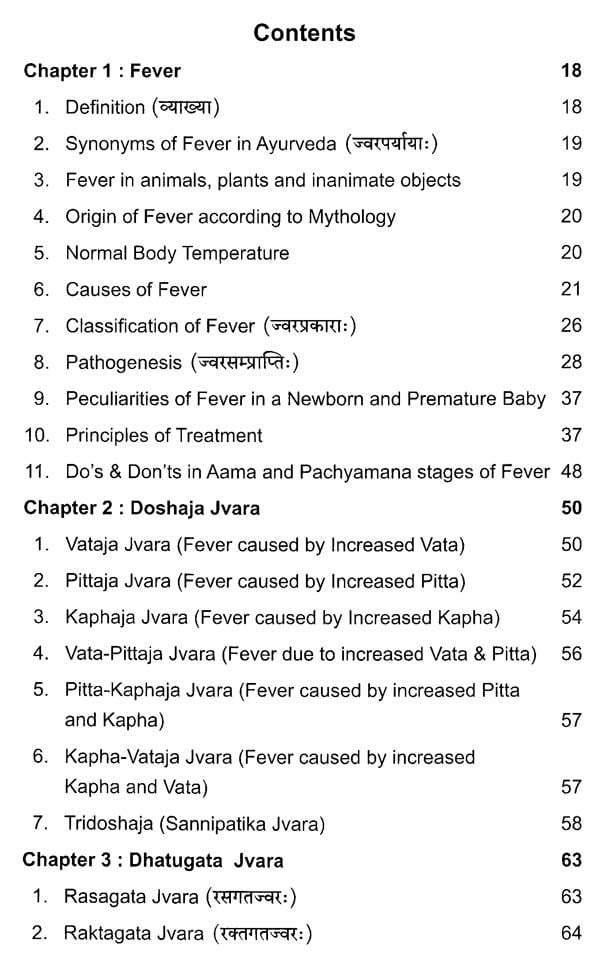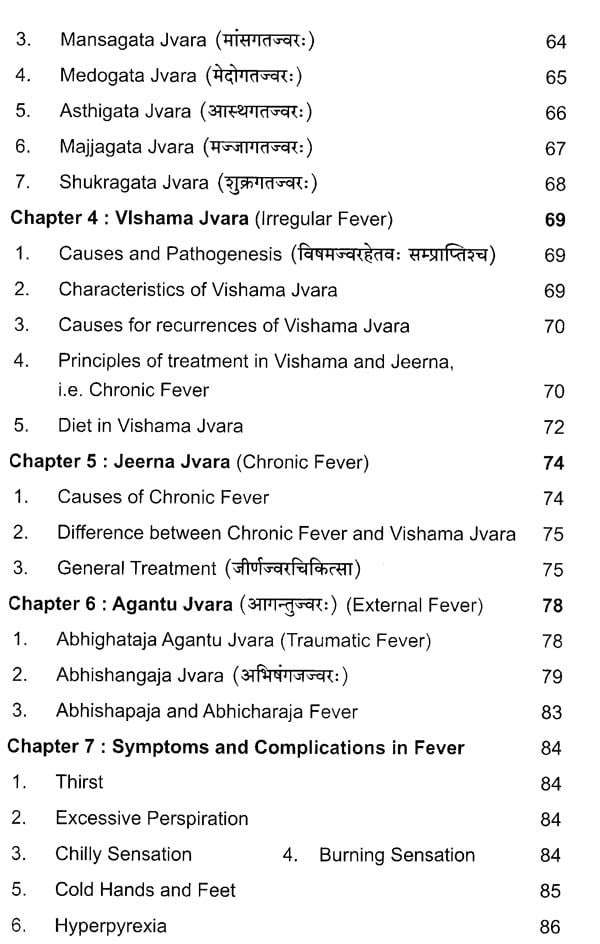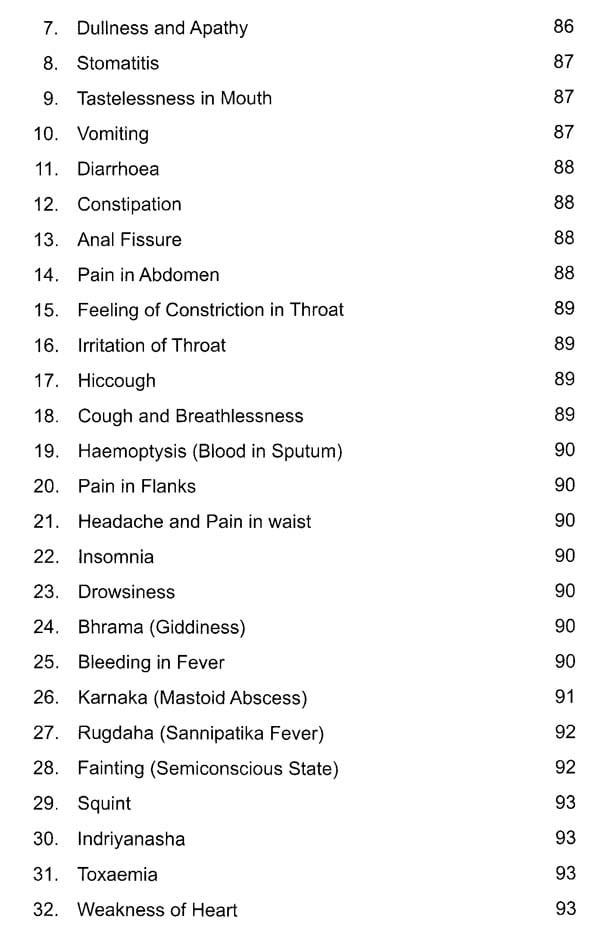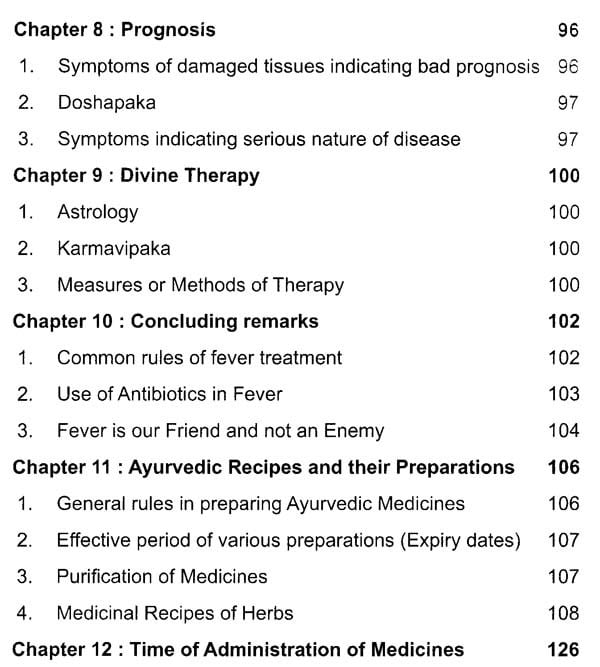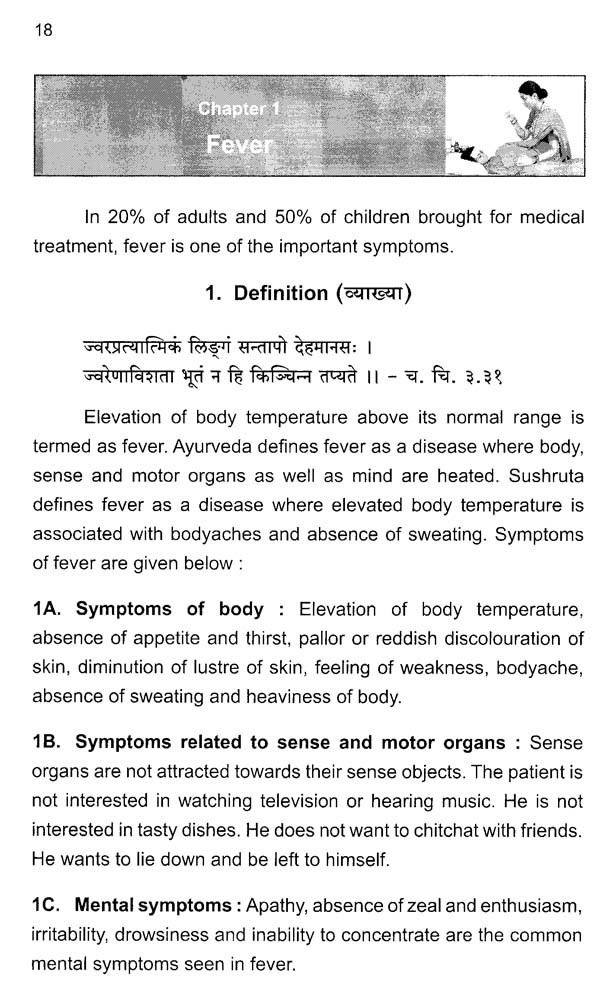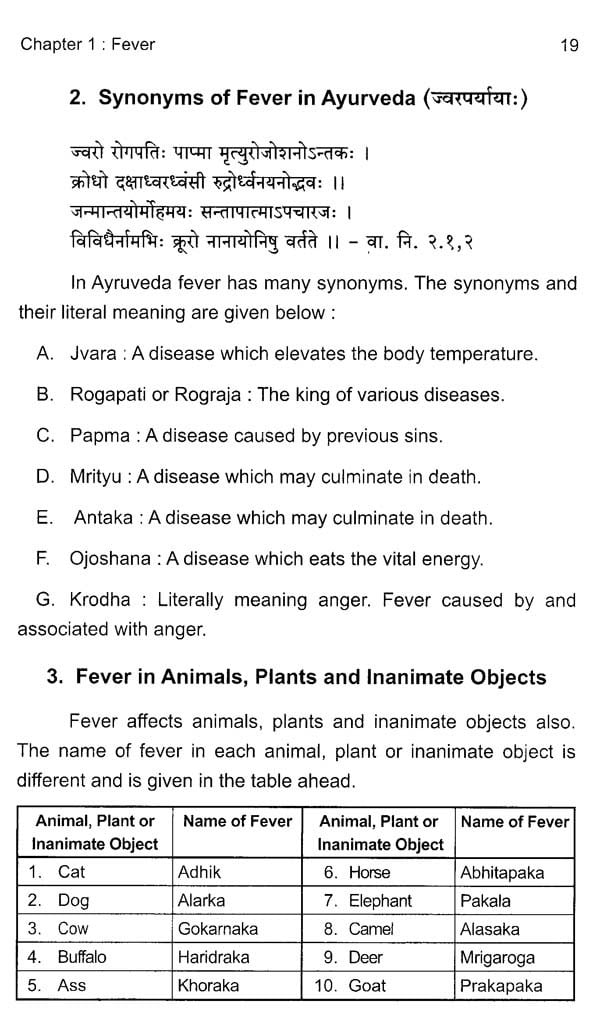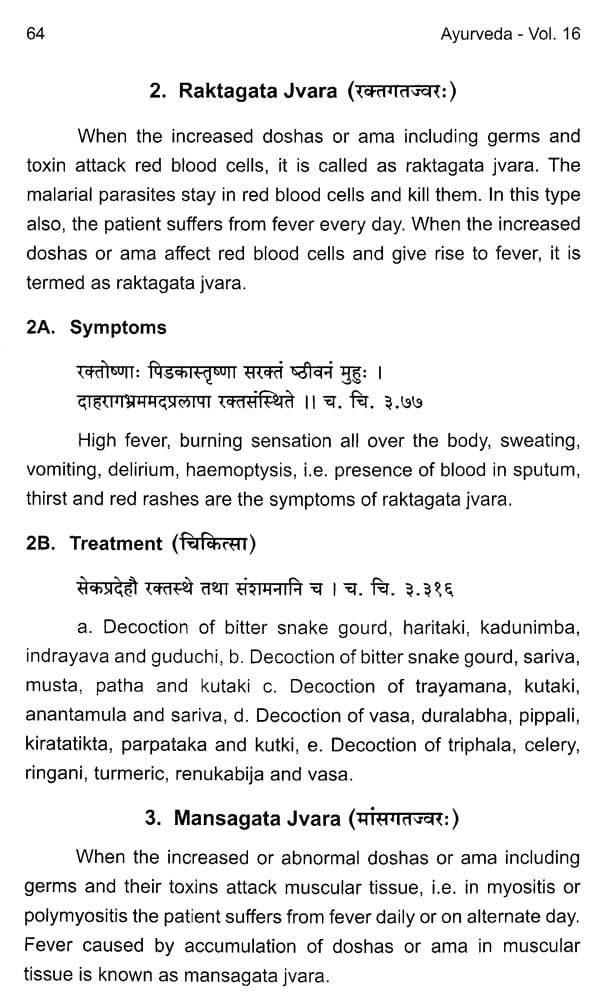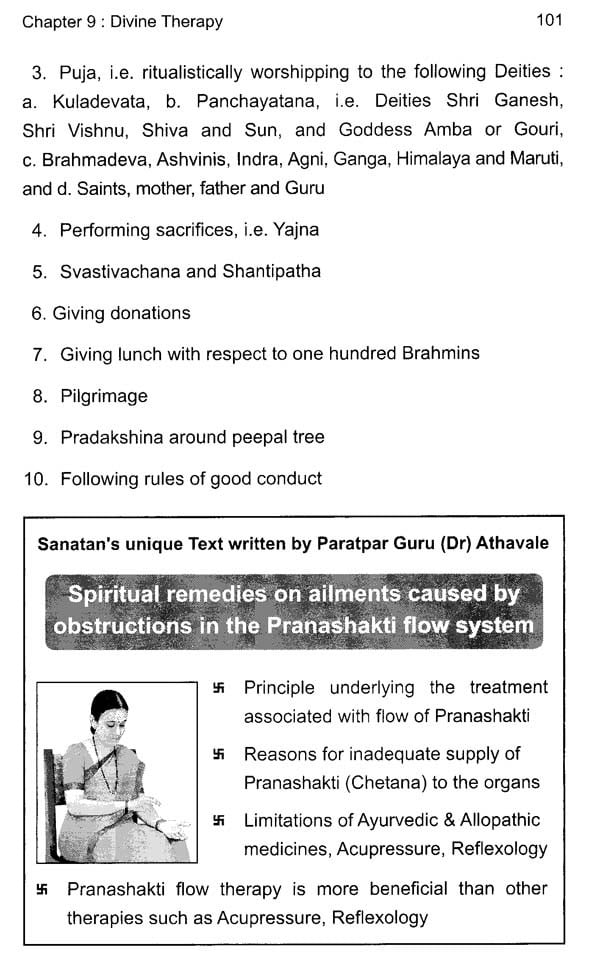
Fever in Ayurveda
Book Specification
| Item Code: | AZB849 |
| Author: | Doctor & Vaidacharya, Sadguru Vasant Balaji Athavale and Dr Kamlesh V Athavale |
| Publisher: | SANATAN SANSTHA |
| Language: | English |
| ISBN: | 9789381746219 |
| Pages: | 132 (Throughout B/W Illustrations) |
| Cover: | Paperback |
| Other Details | 8.5 x 5.5 inches |
| Weight | 164 gm |
Book Description
Sadguru (Dr) Vasant Balaji Athavale was a renowned Paediatrician. He founded the Paediatrics Department in 1959 in Lokmanya Tilak Mahanagarpalika Hospital, Mumbai. He was Professor and Head of this Department from 1960 to 1990. He was the Chairman of the ‘International Conference on Alternative Medicine’ seminar in Bangkok in 1980. In 1996, He received the international honour for the ‘Best author of books on Ayurveda’. In 2001 & in 2012 respectively, He was honoured with the ‘Lifetime Achievement Award’ in an International conference on ‘Ayurveda and Hepatic Disorders’ and by the Indian Academy of Paediatrics.
1. The journey from being a seeker to becoming a disciple
A. Having the quality of selflessness and the attitude of sacrifice, which are essential for spiritual practice : Sadguru Vaidyacharya (Dr) Vasant Balaji Athavale started noting down higher level philosophical thoughts on Spirituality in 1980. He toiled day and night to create a vast treasure of knowledge on Spirituality. He donated this treasure to Sanatan Sanstha (to become Sanatan’s Texts) in 1990. This sacrifice, before He became a Saint indicates the level of His spiritual practice & seekership. Due to His writings, Sanatan’s Texts are now becoming inclusive in the true sense.
B. In 2004, He became Paratpar Guru (Dr) Athavale’s disciple (A great Saint who is also His younger brother and is the Founder of Sanatan Sanstha, the world-renowned spiritual organisation).
2. Attaining Sainthood
On 16.12.2012, He reached Sainthood due to His spiritual emotion, intense yearning, an inquisitive nature & humility.
A. Sadguru Vaidyacharya (Dr) Vasant Athavale attained Saint-hood by performing spiritual practice through various Paths of Spirituality : Every person performs spiritual practice as per some path of Spirituality, becomes introverted, progresses spiritually and thus moves towards Sainthood. However, Dr Vasant Athavale attained Sainthood through Karmayoga (Path of Action) by serving the patients, Dnyanyoga (Path of Knowledge) by writing Holy texts, Bhaktiyoga (Path of Devotion) and Gurukrupayoga (Path of Guru’s grace) by performing spiritual practice as per all these Paths.
3. Active in seva for Sanatan’s mission until His last breath
Sadguru (Dr) Vasant Athavale kept performing satseva for Sanatan’s mission until His last breath. When He came to know of Divine particles found in Sanatan’s Ashram, He inquisitively studied the subject, contemplated on how to conduct research on this topic from a scientific perspective and gave His own suggestions too.
He renounced His body on 9.11.2013 at the age of 80 years.
M.D. (Paediatrics), D.N.B., M.N.A.M.S.;
F.A.A.P. (Paediatrics and Neonatology, USA)
The co-author, Dr Kamlesh V Athavale, ie is the son of Sadguru (Dr) VB Athavale. He has achieved success in examinations of M.D. (Paediatrics), D.N.B., M.N.A.M.S. (India) and F.A.A.P. (Paediatrics and Neonatology, USA). He is working as a Neonatologist at Duke University Medical Centre (USA). He is also Director of Neonatology at Nash General Hospital.
Ayurveda has described fever as the king of diseases. In modern medicine fever is considered as a symptom of many diseases. Though fever is a symptom of cancer, rheumatic diseases, connective tissue disorders etc., in 95?ses germs are responsible for fever. Modern medicine prescribes antibiotics to kill the germs and antipyretics like paracetamol, aspirin and nimesulide to bring down fever temporarily. However in 50% of fevers caused by viral infections antibiotics available at present have no role. In addition in some cases germs gradually become resistant to antibiotics, making antibiotics ineffective. In such cases modern medicine does not have guidelines for treatment and the treatment becomes irrational.
Ayurveda has studied jvara (fever) in detail. In modern medicine the incubation period is described as a period between entry of germs or causative toxins and manifestation of fever. Modern medicine does not offer any treatment in incubation period.
Ayurveda has described 4 stages in the incubation period. They are :
1. Chaya stage : Accumulation of causative factors, i.e. increase in the number of germs or toxins at the site of first landing of germs in the body.
2. Prakopa stage : Further increase in the number of germs and their toxins till the site of first landing of germs is fully saturated with germs.
3. Prasara stage : Spread of germs through lymphatics or the blood stream.
4. Sthanasamashraya : Localisation of germs in a particular organ, e.g. localisation of jaundice virus in liver.
Ayurveda has described the symptoms in each stage and suggested how to treat the patient in each stage so that the disease does not manifest.
Ayurveda considers the causes, symptoms and site of the disease and classifies fever into Vataja, Pittaja and Kaphaja jvara, and outlines the diet and medicines to subdue the increased dosha.
In addition Ayurveda gives tonics, i.e. rasayana to maintain the strength of the organ affected.
If the fever is suppressed in the initial stages, it is likely to become chronic and affect an organ.
Ayurveda has described three stages in fever as follows :
1. Amavastha : Accumulation of toxins in affected organ with rising fever. Ayurveda advises fasting in this stage.
2. Pachyamanavastha : Stage of digestion of toxins. The patient is toxic in this stage and fever is at its peak. Medicines which promote digestion and neutralisation of toxins are indicated in this stage.
3. Pakvavastha Gradual reduction of detoxicated toxins. Ayurveda suggests use of emetics, purgatives or enemas to eliminate the toxins from the body so that fever does not become chronic.
Ayurveda has also described psychological causes of fever, e.g. anger, fear, burning sex desire and their treatment.
Antibiotics are lifesaving drugs and must be used in diseases like pneumonia, tuberculosis, meningitis and even in those moderate infections where they are effective. However, every physician must consider the increased dosha, tissue or organ affected, strength and digestive power of the patient, constitution, age, psychological state, season, diet and stage of the disease while prescribing the diet and medicines for the patient. Thus, if the patient is treated in the initial stage with the appropriate medicines, the disease is likely to take a milder course and the patient can be cured without any complications.
This book will be useful to medical students, doctors, nurses, and every individual because every individual is likely to suffer from fever not once but several times.
We pray to Deity Shiva, God of fever, that by understanding the nature of fever and implementing the preventive measures at an early stage, let humanity be free from fever. - Authors
**Contents and Sample Pages**